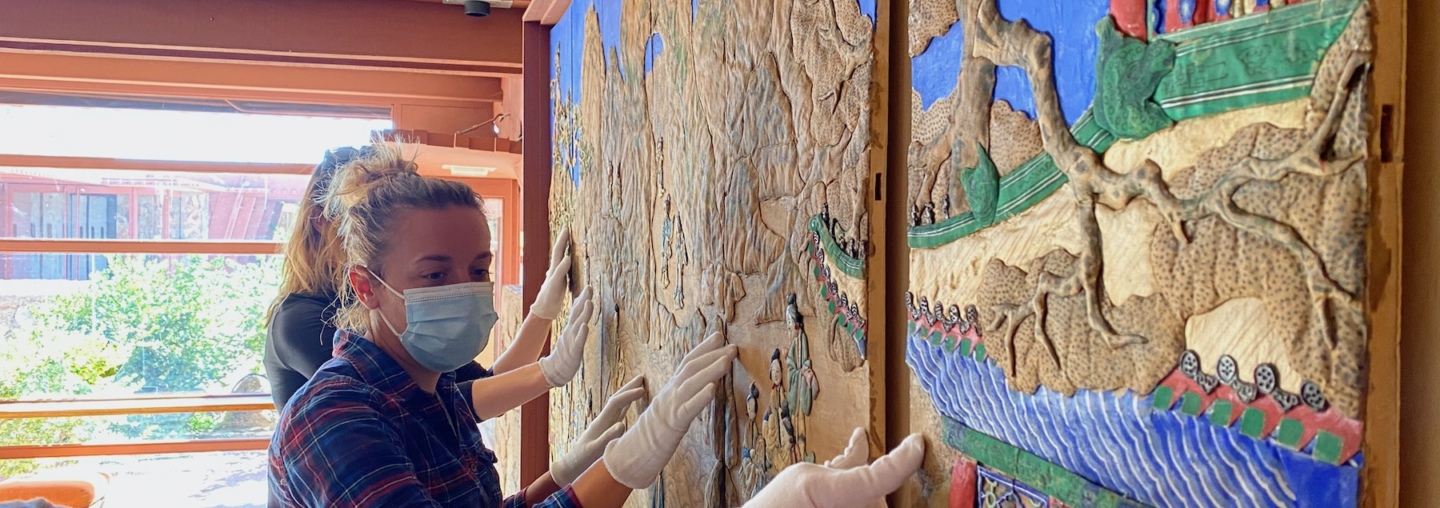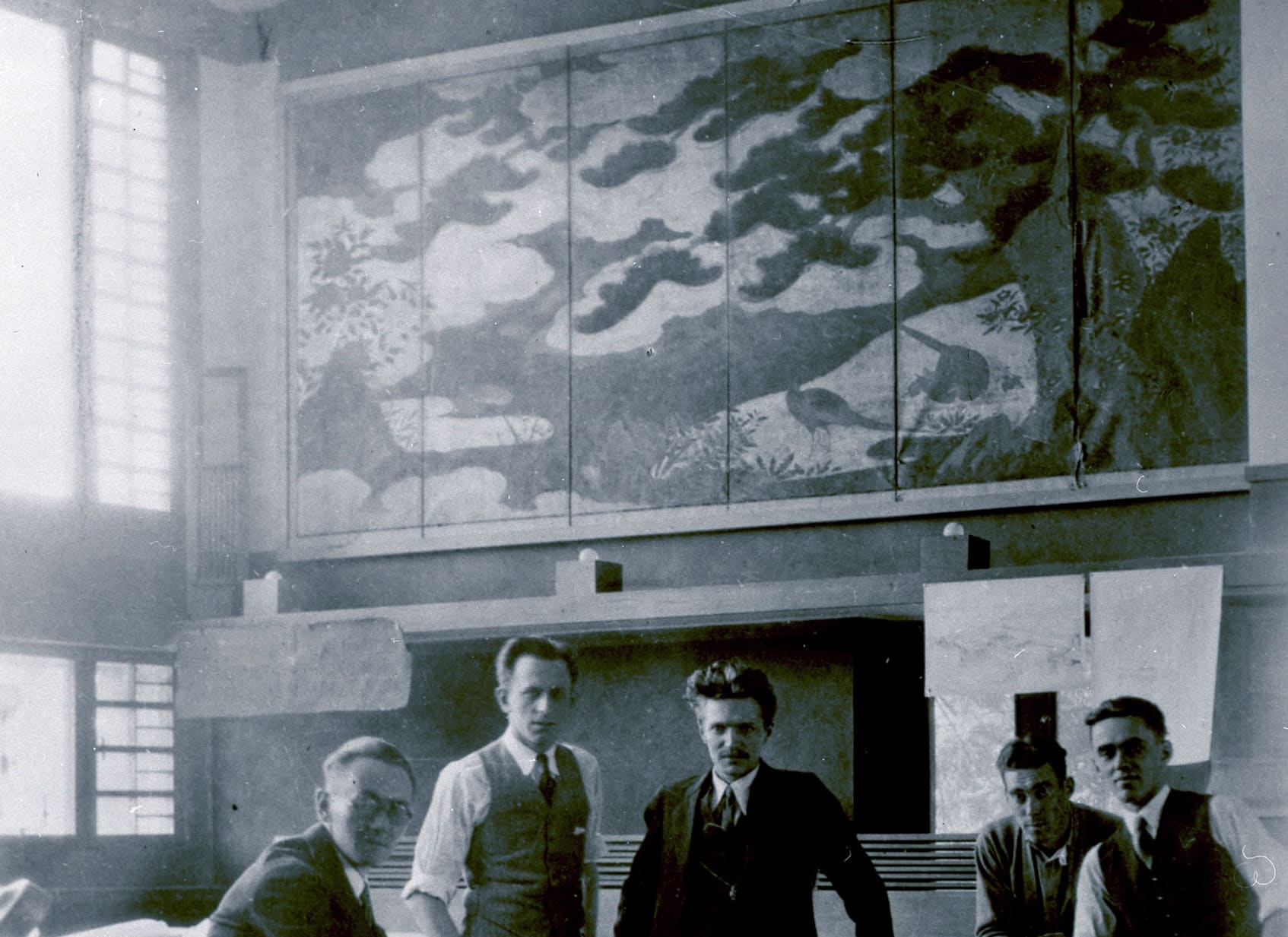
Preserving Frank Lloyd Wright’s Asian Screens
Yadin Larochette | Feb 17, 2021
Frank Lloyd Wright always believed in showcasing his artwork throughout his two homes. His collection of asian screens was no exception. Learn how the Collections & Preservation staff from the Frank Lloyd Wright Foundation work with conservation specialists to preserve and protect these magnificent historic screens while continuing to display Wright’s artwork for future generations to enjoy.
When preserving collections, historic houses may face challenges related to permanent display in often less controllable environments. Light, dust, insects, and temperature and humidity fluctuations are just some of the factors dedicated staff need to contend with. Glass or acrylic glazing placed in front of works can often help mitigate these factors. Frank Lloyd Wright Foundation’s sites are no exception. Comprised of two of Wright’s estates which he designed, the first, Taliesin, is located in his native lush green Wisconsin. The other, referred to as Taliesin West, was his winter escape in the arid Arizona desert. Staff at both locations are tasked with making sure visitors for generations to come have access to the famed architect’s residences and the decorative arts he personally chose and placed to make his spaces home. Wright’s passions and aesthetic sensibilities permeate throughout, continuing to inspire everyone from the casual visitor to the dedicated architecture scholar. The value of the collections is accentuated by Wright’s philosophy: He saw the architecture of a structure, its surroundings, and what decorates within as a whole. “In organic architecture then, it is quite impossible to consider the building as one thing, its furnishings another and its setting and environment still another,” he concluded. “The spirit in which these buildings are conceived sees all these together at work as one thing.”

Figure 1: The “Immortal Peaches” screen displayed at Taliesin West in Arizona. Photo by Andrew Pielage
Wright was drawn to Asian arts, as discussed in a recent Taliesin Talks panel discussion with Frank Lloyd Wright Foundation’s Vice President of Preservation Fred Prozillo, Director and Curator of Collections Margo Stipe, and Chairman of the Frank Lloyd Wright Foundation Board of Trustees T.K. McClintock. McClintock, an art conservator and founder of Studio TKM, Inc., has been instrumental in the conservation of many works in the collection’s holdings.
Among these are several screens which in Japanese interiors would have originally stood on the floor and functioned as space dividers. Wright chose to display them open flat on the wall, affording an intimacy and warmth to their respective spaces. Ryan Hewson, Preservation Director at Taliesin Wisconsin, reviewed the redesigning of the mounting systems as part of the conservation of one of the site’s structures in 2015.
Made of many layers of paper over wooden lattice cores, the screens are fragile in nature, and exposure from permanent display and the ravages of time and alterations in format by Mr. Wright have led Taliesin staff to take action. The various materials used on a screen – paper, silk, media, adhesives – age differently, and light plays a starring role in the degradation process. The ultra-violet (UV) range of the light spectrum is especially damaging and can lead to the fading of colors and weakening of materials. Silk, a main component in The Immortal Peaches (see Fig. 1 and 2), for example, is inherently sensitive to light and tends to age poorly. Smooth and shiny threads turn to powder under long term exposure. Dust from the environment is another culprit in the degradation of the screens: Tiny, air borne sharp particles land on the surface and as ambient relative humidity and temperature cause the various screen components to expand and contract, the particles embed further into the works, compromising the various underlying materials at a microscopic level. Dust and adhesives used also include materials that attract harmful insects such as moths and silver fish.

Figure 2: Detail of “The Immortal Peaches” screen.

Figure 3: The screen “Pine Trees with Pheasants and Ducks” on display at Taliesin in Wisconsin.
The Frank Lloyd Wright Foundation and Taliesin Preservation Inc. brought in McClintock and his team, along with conservator Margot Healey, to preserve the works. They spent thousands of hours over several years painstakingly consolidating, cleaning, and stabilizing the screens by their disassembly and remounting using the original supports in preparation for re-display. Every measure was taken to ensure that these works last as long as possible, including selecting an ultra violet light (UV) blocking glazing to cover them once installed. Glazing not only helps protect works from harmful UV radiation, but also helps keep dust and insects off the surface and can help buffer fluctuations in environmental temperature and relative humidity.
Optium Museum Acrylic, manufactured by Tru Vue, Inc. was chosen for both the protection and viewing experience it offers. Optium is light weight, about half the weight of glass, and shatter resistant. Standard acrylic has a high electro-static charge, however, which attracts dust and can also attract friable media in the framed work, such as those in The Immortal Peaches.

Figure 4: Historic photograph at Taliesin with “Pine Trees with Pheasants and Ducks” displayed above.
Optium has even less static than glass, and is also anti-reflective, which can significantly enhance a viewer’s experience compared to other glazing. The reflections from typical glazing can be really distracting and details of an artwork tend to get lost, especially when there is depth and texture to the works. Typical glass and acrylic reflect back about 8% of light, leaving the viewer looking at their own reflection and surroundings. Optium, on the other hand, reflects 1.6% at most. Under optimal lighting, the glazing virtually disappears. Optium is also abrasion resistant, which makes it last significantly longer than other softer or non-treated acrylics which get hazy from micro scratches after only a short period of time. And last but certainly not least, Optium Museum Acrylic blocks 99% of harmful UV radiation.
The largest sheets of Optium Museum Acrylic currently manufactured are 72 inches by 120 inches, which led to significant challenges when glazing the larger Pine Trees with Pheasants and Ducks (see Fig. 3 and 4). Luckily, two or more sheets can be seamed together, as discussed in a previous blog post, Conservation of Japanese Screen at Taliesin which includes a video of the installation process (Small Corp. donated this service).
Today, these magnificent works of art are protected and accessible, waiting for your visit. May they continue to inspire for generations to come!




